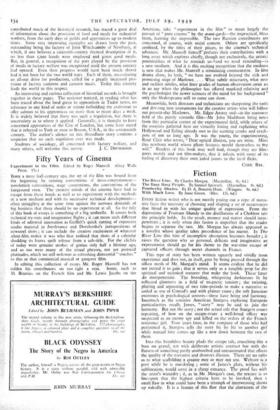Fifty Years of Cinema
BORN a mere half-century ago, the art of the film was bound from the beginning by existing conventions of mass-cntertainment- novelettish conventions, stage conventions, the conventions of the fairground even. The creative minds of the cinema have had to escape from these bonds as well as to experiment with the methods of a new medium and with its successive technical developments— often struggling at the same time against the nervous demands of big business that there should be no experiment at all. So the title of this book of essays is something of a big umbrella. It covers both technical try-outs and imaginative flights ; it can mean such different kinds of editorial innovation as Griffith's quick cutting of expensive studio material in Intolerance and Dovzhenko's juxtapositions of newsreel shots ; it can include the creative excitement of whatever silent-film maker it was who first realised that shots of a calendar shedding its leaves spelt release from a sub-title. For the clichés of today were genuine strokes of genius only half a lifetime ago, and so too were many of the yisual phrases, not yet pictorial platitudes, which we still welcome as refreshing directorial " touches " to this or that commercial musical or gangster film.
In editing this collection of essays Mr. Roger Manvell has not ridden his contributors on too tight a rein. Some, such as M. Brunius on the French film and Mr. Lewis Jacobs on the
American, take "experiment in the film" to mean largely the pursuit of "pure cinema" by the avant-garde—the impractical, bless them, hunting the impossible. The two Russian contributors are concerned, of. course, with social content. Others are specifically confined, by the titles of their pieces, to the cinema's technical advances. Mr. Manvell himselYprefaces their contributions with a long essay which explores chiefly, though not exclusively, the artistic potentialities of what he reminds us-sand we need reminding—is a new medium. And it is this exciting recognition that the medium is new that makes Mr. Manvell a stimulating commentator. In film drama alone, he feels, "we have not evolved beyond the rich and promising stage of Marlowe. . . . What subtle structures, what new and sudden similes, what finer grades of human observation await us in an age when the philosopher has offered mankind relativity and the psychologist the newer sciences of the mind for his background" only the Shakespeares still to come can show.
Meanwhile, both directors and technicians are sharpening the tools and devising new instruments for the creative artists who will follow our present-day Marlowes. Mr. Edgar Anstcy and—in the narrower field of the purely scientific film—Mr John Maddison bring news from this particular corner of the experimental field, while others of the essayists gathered here are virtually listing and explaining what Hollywood and Ealing already owe to the seeming cranks and crack- pots of not so long ago. It was the young, the experimenting, Rene Clair who wrote, "Dear optical illusion, you are mine. Mine this newborn world whose pliant features mould themselves to my will." Readers of this book may well find, though they are film- goers merely and not film-makers that it infects with some of its feeling of discovery their own jaded jaunts to the local flicks.
Cvan. RAY.


































 Previous page
Previous page